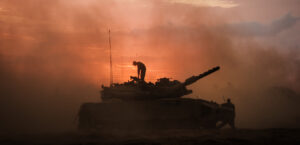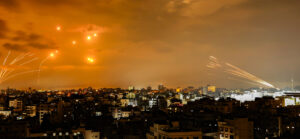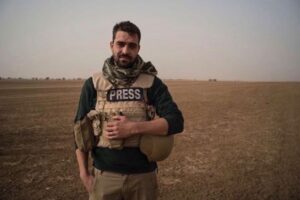In one of the opening scenes of Evelyn Waugh’s Men at Arms, the central character Guy Crouchback vacates his Italian castle in 1939 once the approaching conflagration can no longer be ignored. “He expected his country to go to war in a panic, for the wrong reasons or for no reason at all, with the wrong allies, in pitiful weakness,” Waugh writes of his honourable, fallible stand-in. “But now, splendidly, everything had become clear. The enemy at last was plain in view, huge and hateful, all disguise cast off. It was the Modern Age in arms.” The looming catastrophe was, in all its awful novelty, the birth pangs of our own age.
No wonder our society returns obsessively to what we still call “the war”, like an adoptee, severed from his roots, searching for meaning. But of all the explorations since, in film and fiction and popular history, one treatment cannot be bettered. It was 50 years ago this week that Thames TV broadcast what has since become renowned as the greatest documentary series ever made: The World at War. It is impossible to imagine ITV making it now, but then, it is impossible to imagine today’s BBC making it either.
The intellectual gulf between, say, 1997’s The Nazis: A Warning from History (a documentary about the rise of National Socialism) and 2019’s The Rise of the Nazis (a parable about Trump and Brexit, featuring Ash Sarkar and Sir Mike Jackson, doubtless the fruit of a researcher’s Twitter search for a communist and a general) is unbridgeable. It is, simply, unthinkable that any television station today would spend two years and vast sums of revenue hauling out unseen footage from state archives for 26 hours of prime-time history programming, nor present the results with such intellectual and moral sophistication.
But even then, it was prestige television: with an eye to international sales, Laurence Olivier was drafted in to provide the voiceover, with only his eccentric pronunciation — “Shtaleen”, “the Ukryne”— breaking the illusion of an omniscient observer detailing mankind’s foibles. In tones shifting scene by scene from sardonic dismissal of the human frailties and delusions underlying war to cold contempt and sorrowful, clipped pity at the sheer waste of it all, the pathos of Olivier’s narration is central to the series’ artistic success.
From the very first lines, opening in the ruins of the French village of Oradour-sur-Glane, whose inhabitants were massacred by the SS, the script’s spare, cold poetry builds the frame that allows the following footage to breathe. “Down the road, on a summer’s day in 1944, the soldiers came. Nobody lives here now,” Olivier intones with the mournful rhythm of a funeral bell, in a script drafted by Neal Ascherson. “They were here for only a few hours. When they left, a community which had lived for over a thousand years was dead,” and Oradour left a village whose “martyrdom stands for thousand upon thousand of other martyrdoms in Poland, in Russia, in Burma, in China — in a World at War”.
Over the 26 hour-long episodes (streamable today in truncated form on UKTV Play), the Glaswegian-Jewish auteur Jeremy Isaacs produced an epic of unimaginable scope, interweaving the grand narrative of geopolitics with the personal recollections of the soldiers, diplomats and civilians involved, across campaigns reaching from the Russian steppes to the American heartland and the jungles of the Pacific. The cast list of interviewees is extraordinary: whole documentaries could surely be pieced together today from its offcuts. Where else could Admiral Doenitz pop up as a briefly-used talking head to talk us through the intricacies of Germany’s U-boat campaign, Anthony Eden (billed as Lord Avon) and Lord Mountbatten to unveil Whitehall’s thinking, Adolf Galland outline the Luftwaffe’s failings in the Battle of Britain or Arthur Harris and Curtis LeMay give us their unrepentant insights into the virtues and limitations of strategic bombing?
Thirty years after the events themselves, the series was made at just the right time for a work of history: long enough for its participants, late-middle-aged in their Seventies suits, to achieve some distance from their younger selves, but too close to have become memorialised, locked away in myth with the rest of the distant past. The passage of time alone means the series is unreplicable now: the great work of television history has become the matter of History in itself. Even the reminiscences of the less notable participants, the French and German and Italian army officers sitting in their book-lined studies recounting their war in cut-glass English accents, the cockneys sharing stories in a smoke-filled East End pub or the Royal Navy veteran matter-of-factly, almost innocently, describing his feelings of what we would now term Post-Traumatic Stress, are visions of a lost world.
The recollections of the survivors interviewed are the series’ backbone, but perhaps taken for granted is the faultless tradecraft of the researchers who tracked down and won their confidence: embedded within this work of history are moments of pure journalism at its best. Perhaps counterintuitively, for a series now coded as “male interest”, The World At War’s greatest strengths are built on the meticulous skill and craftsmanship of its little-praised female production staff. To unlock the memories of the Nazi interviewees, Isaacs wrote, “Susan McConachy, blonde and blue-eyed, was our star” finding and interviewing Hitler’s secretary, Traudl Junge, whose intimate recollections of the regime bunker Götterdämerung have, via the film Downfall, since entered popular mythology. McConachy’s “worst moment”, Isaacs noted, “came when Karl Wolff, Himmler’s adjutant, put his hand on her knee and confided: ‘My dear, you are just the type from whom we liked to breed.’”
Yet her discomfort brought dividends. As McConachy later wrote of the “most charming” Wolff, “After lunch I asked him to repeat the story he had told me one evening over supper about an incident at Minsk at which he had been present, when a hundred people were shot into an open grave as a demonstration for Himmler. He looked a bit surprised. He had forgotten that he had ever mentioned that. Then the film ran out. I wondered if, with time to think, he would actually tell the story again. When we were ready to go he did in fact tell it. I was relieved, not just because I’d got the story, but because he’d had the time to reflect on what the consequences of telling it might be and I could feel less responsible if he did in fact end up in court again when the programme was shown.”
The scene itself, with the mixed emotions playing across Wolff’s face as he tells the story of Himmler turning green beside the pit as his face was splashed with a victim’s brains, is extraordinary. No less powerful, or compelling in its moral complexity, is episode director Martin Smith’s interview with Albert Speer in the Holocaust episode Genocide, the single episode screened without accompanying music or advertising breaks. Hitler’s armaments minister recounts, with a sort of hesitant uncertainty as to how his testimony will be received, being warned not to visit the camps “because horrible things would happen. This, together with other hints I got, should have made — should have made my decision to go to Hitler immediately, or to Himmler, and to ask them what is going on and to take my own steps, but I didn’t do it, and not doing it was, so I think nowadays, the biggest fault in my life.” As Isaacs later noted laconically, “Albert Speer, surely, was economical with the truth,” but the episode doesn’t labour the point and moves on swiftly to the next scene: the viewer was trusted, once again, to make up his own mind.
As our distance from the war itself has increased, the more rigid and formulaic our emotional responses to it have become: it has become a moral parable, justifying all manner of political malignancies, rather than a narrative of the tragedy inherent in international politics. It is doubtful that, even if we still had access to senior Nazi officials, contemporary mores would allow them to be interviewed dispassionately as witnesses to history. While Smith restrained his personal disgust, it is all too easy to imagine Stacey Dooley storming out of an interview with Speer after giving him a piece of her mind. Yet the series did not shy away from the war’s horrors: if anything, its sheer sparseness made them more vivid, as in the episode intercutting the testimony of Holocaust survivors with the reminiscences of an SS camp guard throwing children into the gas chamber, blankly remarking that “you get used to anything in time”. The war itself has passed into myth: The World at War returns it to the realm of human memory.
When I was young, The World at War made me want to see war for myself, and record it for posterity. Rewatching it now, having experienced a decade of close combat and great human suffering in the intervening period, what strikes me most is the sheer quality of the combat footage, obtained by unnamed cameramen on all sides who may or may not have survived their labours. The intensity reminds us that even the most experienced journalist today has never seen war on such a scale: at least, not yet. The almost expressionist editing of their uncredited footage, the long periods when the voiceover and music trails off for bricolaged images of pure chaos, still pays the appropriate honour to their work.
In her finding and choosing of footage, another of Isaacs’ female production staff, the archive researcher Raye Farr, was responsible for the extraordinary vividness of the series. Realising that the propaganda newsreels of the day provided only stilted, sanitised highlights, Farr searched the state archives of Europe for unused offcuts, too strange or uncomfortable for showing at the time. In the German Bundesarchiv in Koblenz, Farr pestered the director for access to uncatalogued treasures, noting later that “not until you have made a nuisance of yourself do the staff throw up their hands in exasperation and say, ‘See for yourself’ — which is what you’ve been waiting for”.
The results of her tradecraft, perhaps taken for granted by viewers, are central to the series’ success. As Isaacs later wrote, among Farr’s uncatalogued finds “was material shot behind the German lines on the Eastern Front by a gifted documentary cameraman. He appears not to have been shooting for the newsreel. Some of his footage was almost idyllic, showing soldiers at rest and leisure. Other sequences were more menacing. He filmed three German soldiers gently, almost reluctantly, but, in the end, firmly clearing a village of its people, sending the men in one direction, the women and children in another. Somehow, we know they will never see each other again.”
As we wait in 2023, hoping to evade what may be an equally great conflagration, both Crouchback’s fictional insight in Men at Arms, and The World at War’s wise and humane cataloguing of the real-world results seem unbearably poignant. The flames of war are already engulfing the world that came into being in 1945: what comes after may be better or worse, but it will be different from anything we have ever known — just as much as the proud, globe-spanning Britain of 1939 differed from the humbled, impoverished Britain of 1945.
Within nations as well as between them, the battle lines are already being drawn. Cities will be levelled, entire peoples exiled, humans killed in hi-definition video for the applause of social media spectators. Our own age is taking up arms, waiting to usher us into its cold embrace. May future generations judge us as soberly and compassionately as the makers of The World At War.
Disclaimer
Some of the posts we share are controversial and we do not necessarily agree with them in the whole extend. Sometimes we agree with the content or part of it but we do not agree with the narration or language. Nevertheless we find them somehow interesting, valuable and/or informative or we share them, because we strongly believe in freedom of speech, free press and journalism. We strongly encourage you to have a critical approach to all the content, do your own research and analysis to build your own opinion.
We would be glad to have your feedback.
Source: UnHerd Read the original article here: https://unherd.com/




